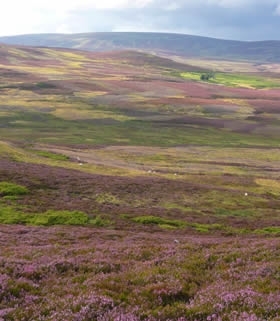UPDATED 23rd May 2016 to include links to paper in question
by Andrew Gilruth, GWCT Director of Communications
Britain’s beautiful heather clad moors were created thousands of years ago – by man. As forest clearance increased, the open heath, rough grass and bogs began to form.
Ancient settlers here and in Denmark, Norway and Sweden are known to have used fire and grazing as management tools to clear woodland and supress regeneration. Indeed, some peatland plant populations have evolved alongside fire management, and are now well adapted to thrive in this environment.
Heather burning - a recognised conservation tool
Across Europe scientists are promoting the reintroduction of burning – to protect and restore globally-rare heathland and moorland. Best practice on burning is informed by this growing body of scientific literature, much of it emerging from the UK. Bizarrely, individuals ‘closely associated with the RSPB’ are using the same science to call for a ban on burning.
A recent paper1 accepted for publication by the peer-reviewed flagship biology journal of the Royal Society (the world's longest-standing scientific society), assessed the science behind the arguments, and highlighted media bias around reporting on this issue. This comprehensive review thoroughly assessed the scientific literature and concludes that the following commonly held views are not verified by the evidence currently available and should not be perpetuated in discussions until they are formally addressed:
X regular burning increases heather dominance
X fire kills or significantly damages Sphagnum moss
X peatlands are particularly sensitive sites with regard to fire
X the interaction between wildfires and managed burning is clear
X fire alone can contribute to peatland degradation
Heather burning - on grouse moors
Fire is still a commonly used agricultural tool, with farmers and crofters across the UK burning grass, heather and furze. That said, much of the heather burning we still see today takes place on grouse moors. For the last 200 years gamekeepers have burnt long narrow strips of mature heather on a rotation. How often depends on how quickly the heather becomes both woody and unpalatable, and tall and unavailable. The patches may be burnt every eight to thirty years.
By creating a patchwork of different aged heathers a gamekeeper knows he will always have some young heather for grouse, sheep, deer and mountain hares to feed on that is nutritionally richer and more digestible. Gamekeepers are using a natural process, fire, to facilitate a vital role in plant regeneration. This regeneration is good for many classic moorland animals, for the habitat itself and when done well for the carbon and water balance.
A recent study2 of heather burning in the Peak District concluded that, where they looked, it is being done well. It does conform to best practice guidelines: the overall area burned is small; individual fires are of an appropriate size; and the risk of escape to wildfire is low.
Heather burning – in the press
Another important issue highlighted by these well-respected (and seemingly frustrated) scientists is the bias associated with science reporting in the media.
With heather burning closely associated with grouse moor management, the authors ‘suspect that much of the contextualisation in recent fire-related studies stems less from evidence of the environmental effects of managed burning and more from attitudes towards the forms of land ownership’. They identified three press releases issued by the RSPB last year in response to a single scientific paper that focused on the “damaging” effect of fire – and which ‘bear only a passing resemblance to the key findings’.
They also felt it was clear that journalists relied on press releases from campaigning organisations, to produce sensational stories, without reading the original paper or consulting an independent academic expert. Modest investigation would have revealed the research conducted on the RSPB’s Abernethy Forest Reserve from 2011 that demonstrated the value of burning as a tool to manage both Capercaillie and woodland expansion at forest-moorland edges.
The paper states that if we want to retain our diverse moorlands and peatlands much more research is urgently needed, but in the meantime:
- We should all keep an open mind until the evidence is much clearer and consensus reached
- More co-operation between individuals and organisations is essential
- The conversation should move away from ‘unhelpful hyperbole’
- Reporting should be neutral and balanced, with clear distinctions between evidence and opinion
- Accept that fire is a vital part of moorland management and we should focus on learning how to do it well
One last fact for you – the paper estimates that 0.68% of heather moorland in Britain is burned each year on an average rotation of 147 years.
For previous GWCT comments on heather burning stories in the media see here and here.
1. Davies G, Kettridge N, Stoof C, et al. The role of fire in UK peatland and moorland management; the need for informed, unbiased debate. Philos Trans R Soc B. 2016; In press.
2. Allen KA, Denelle P, Ruiz FMS, Santana VM, Marrs RH. Prescribed moorland burning meets good practice guidelines: A monitoring case study using aerial photography in the Peak District, UK. Ecol Indic. 2016;62:79-85. doi:10.1016/j.ecolind.2015.11.030.
Free Heather Burning Guide
Download our free heather burning guide, extracted from the pages of our bestselling book The Moorland Balance.
Download now >